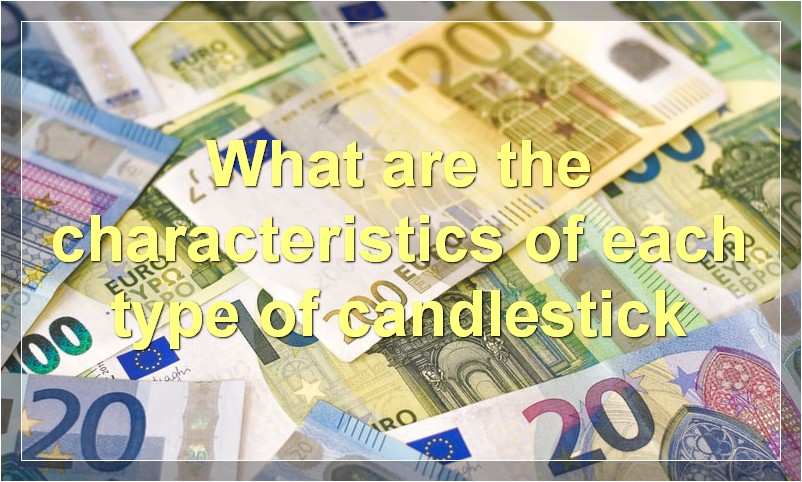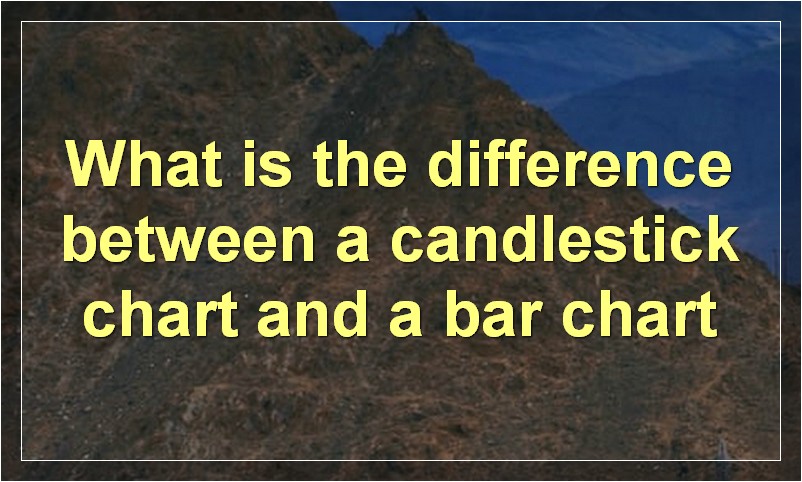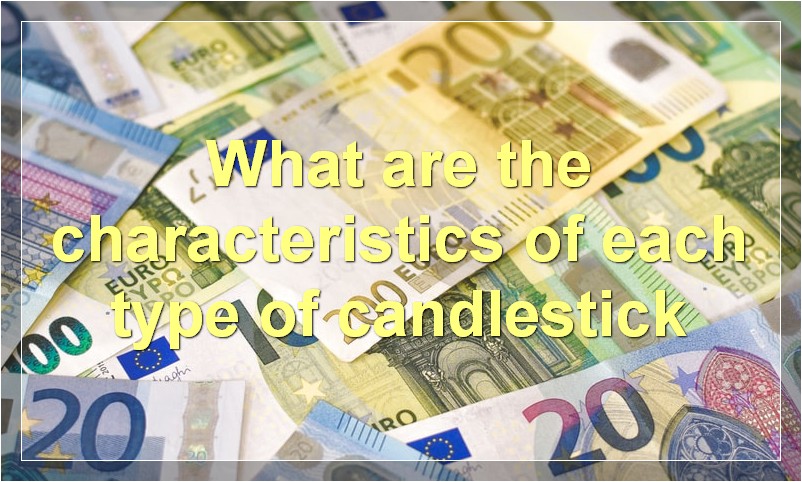If you want to get ahead in the stock market, it pays to know about candlesticks. These powerful tools can help you make better-informed trading decisions, and they’re not nearly as complicated as you might think.
What are the different types of candlesticks
Candlesticks are one of the most popular charting tools used by traders and investors. They provide a visual representation of price action and can be used to identify trends, reversals, and other important market information.
There are many different types of candlesticks, each with its own meaning and interpretation. Here is a brief overview of some of the most commonly used candlesticks:
Doji: A doji is a type of candlestick that has no real body (the distance between the open and close is small). This usually happens when the market is in indecision or consolidation.
Hammer/Hanging Man: Hammers and hanging men are reversal patterns that occur at the bottom of downtrends. They are typically characterized by a small real body with a long lower shadow.
Bullish Engulfing: Bullish engulfing patterns occur when a small black candlestick is followed by a large white candlestick. This is considered a bullish reversal pattern as it indicates that buyers are starting to take control of the market.
Bearish Engulfing: Bearish engulfing patterns occur when a small white candlestick is followed by a large black candlestick. This is considered a bearish reversal pattern as it indicates that sellers are starting to take control of the market.
Morning Star/Evening Star: Morning star and evening star patterns are three-candlestick formations that signal a reversal in the current trend. They typically consist of a small candlestick, followed by a large candlestick, followed by another small candlestick in the opposite direction of the trend.
These are just some of the many different types of candlesticks that are used by traders and investors. If you want to learn more about candlesticks and how to use them, there are many resources available online and in books.
What are the characteristics of each type of candlestick

Candlesticks are used to give traders an indication of the prevailing market sentiment, as well as to provide clues about future price movements. There are four main types of candlesticks:
1. Bullish candlesticks: These candlesticks have small bodies and large upper shadows, indicating that although prices have fallen during the period, they have rebounded strongly before the close. This is seen as a bullish sign, as it shows that buyers are willing to step in and support prices even when they are falling.
2. Bearish candlesticks: These candlesticks have small bodies and large lower shadows, indicating that prices have risen during the period but then fallen back sharply before the close. This is seen as a bearish sign, as it shows that sellers are willing to step in and drive prices down even when they are rising.
3. Doji candlesticks: These candlesticks have small bodies and no upper or lower shadow, indicating that prices have been range-bound during the period with no clear direction. This type of candlestick is often seen as a sign of indecision in the market, and can be used as a leading indicator of a potential trend change.
4. Hammer/hanging man candlesticks: These candlesticks have small bodies and long lower shadows, indicating that prices have fallen sharply during the period but then rebounded before the close. This type of candlestick can be either bullish or bearish depending on the context, but is typically seen as a bullish sign after a prolonged downtrend, as it shows that buyers are starting to step in and push prices higher.
How can candlesticks be used to predict future market movements
Candlestick charts are one of the most popular tools used by traders to predict future market movements. Each candlestick on the chart represents a certain period of time, such as one day or one hour, and shows the open, high, low, and close price for that period. Candlesticks can be used to predict future market movements by looking at the shape, size, and color of the candlesticks.
The shape of a candlestick can give clues about the future direction of the market. For example, candlesticks with long upper shadows and small lower shadows are called “hammer” candlesticks, which typically indicate that the market is going to move up. Candlesticks with long lower shadows and small upper shadows are called “inverted hammer” candlesticks, which typically indicate that the market is going to move down.
The size of a candlestick can also give clues about future market movements. Candlesticks that are much larger or smaller than the surrounding candlesticks are called “engulfing” candlesticks. An engulfing candlestick that is much larger than the surrounding candlesticks typically indicates that the market is going to move in the same direction as the candlestick (up if it’s a bullish engulfing candlestick, down if it’s a bearish engulfing candlestick).
The color of a candlestick can also give clues about future market movements. Candlesticks that are red indicate that the stock closed lower than it opened (a bearish signal), while candlesticks that are green indicate that the stock closed higher than it opened (a bullish signal).
What are some common candlestick patterns
There are a few common candlestick patterns that technical analysts look for to try and predict future price movements. These candlestick patterns are: the doji, the hammer, and the inverted hammer.
The doji is a candlestick pattern that indicates indecision in the market. It is created when the open and close prices are equal, or very close to each other. A doji on its own is not necessarily a signal to buy or sell, but if it appears after a long bullish trend it could be an indication that the market is starting to turn.
The hammer and inverted hammer patterns are both created when the market is falling and then reverses. The difference between the two is that the hammer has a small body with a long lower shadow, while the inverted hammer has a small body with a long upper shadow. These patterns can be used as a signal to buy when they appear after a bearish trend.
How do you construct a candlestick chart
A candlestick chart is a type of financial chart that is used to visualize price data over a given time period. Each candlestick on the chart represents one unit of time, typically one day. The candlestick chart is composed of four main elements: the open, high, low, and close price for the given time period. The open price is represented by the top of the candlestick body, while the close price is represented by the bottom of the candlestick body. The high and low prices are represented by the upper and lower shadows, respectively.
The candlestick chart is a useful tool for technical analysis and can be used to identify potential trading opportunities. For example, a bullish candlestick pattern (e.g., a hammer or inverted hammer) may indicate that prices are likely to move higher, while a bearish candlestick pattern (e.g., a shooting star or hanging man) may indicate that prices are likely to move lower. Candlestick charts can also be used in conjunction with other technical indicators to confirm trading signals.
What is the difference between a candlestick chart and a bar chart

Candlestick charts and bar charts are both used to visualize price data over time. However, there are some key differences between the two types of charts.
Candlestick charts are more visually appealing than bar charts and can give traders a better sense of market momentum. They also make it easy to identify patterns such as reversals and continuation.
Bar charts are more simple and straightforward, making them easier to read and interpret. They are also more common than candlestick charts, so traders may be more familiar with them.
Overall, both candlestick charts and bar charts have their own pros and cons. It’s up to the individual trader to decide which type of chart they prefer.
What is the difference between a candlestick chart and a line chart
A candlestick chart is a type of financial chart that is used to track the price movement of a security over time. The candlestick chart consists of a series of “candlesticks” that each represent the open, high, low, and close prices for a specific period of time.
A line chart is a type of financial chart that is used to track the price movement of a security over time. The line chart consists of a series of “lines” that each represent the open, high, low, and close prices for a specific period of time.
What are the benefits of using candlestick charts
Candlestick charts are one of the most popular types of financial charts used by traders and investors. There are many benefits of using candlestick charts, including the ability to spot trends, identify reversals, and find support and resistance levels.
One of the biggest benefits of using candlestick charts is that they can help you spot trends. A trend is simply a direction in which the market is moving. By looking at a candlestick chart, you can easily see which way the market is moving and how strong the trend is.
Another benefit of candlestick charts is that they can help you identify reversals. A reversal is when the market changes direction. Candlestick charts can show you when the market is about to reverse by identifying certain patterns.
Finally, candlestick charts can also help you find support and resistance levels. Support and resistance levels are price levels where the market has a hard time breaking through. By finding these levels on a candlestick chart, you can make better-informed trading decisions.
Are there any drawbacks to using candlestick charts
Candlestick charts are one of the most popular ways to visualize data, but there are a few drawbacks to using them. First, they can be difficult to read if you’re not used to them. Second, they don’t always give you the most accurate picture of what’s happening with the data. Finally, they can be misleading if you don’t know how to interpret them correctly.
What are some tips for interpreting candlestick charts
Candlestick charts are one of the most popular ways to visualize stock data, and for good reason – they’re easy to read and can provide a wealth of information at a glance. Here are a few tips for interpretation:
1. First, take a look at the overall trend. Is the stock going up, down, or sideways?
2. Next, look at the individual candlesticks. The “body” of the candlestick represents the open and close prices, while the “wicks” show the high and low prices.
3. Candlesticks can be either bullish or bearish. A bullish candlestick has a small body and long wicks, indicating that prices moved lower but then recovered. A bearish candlestick has a large body and short wicks, indicating that prices moved higher but then fell back down.
4. Finally, pay attention to patterns in the candlesticks. Repeating patterns can often give clues about where prices are headed next.

